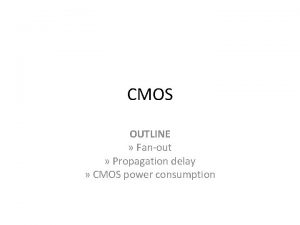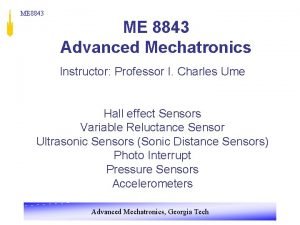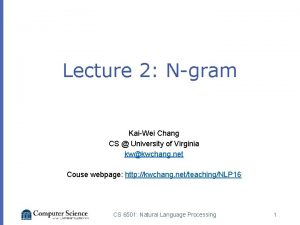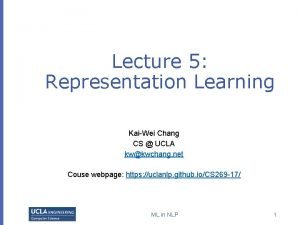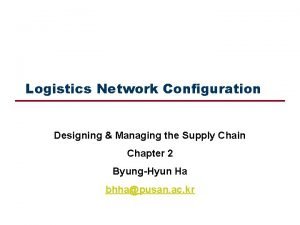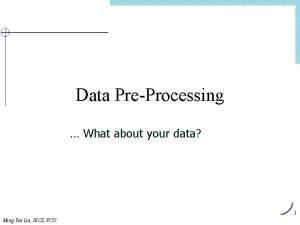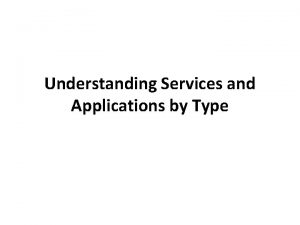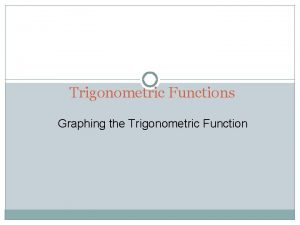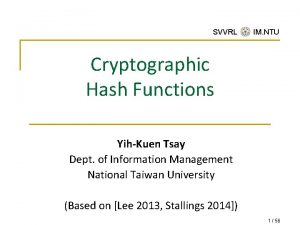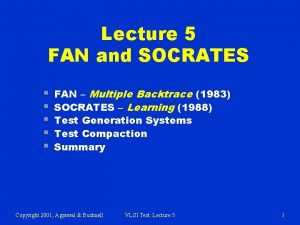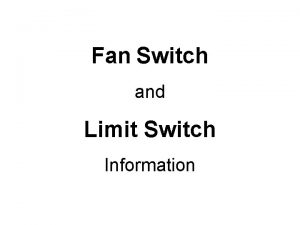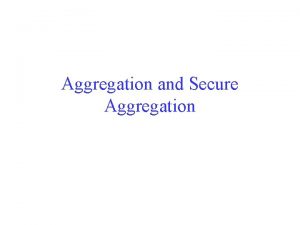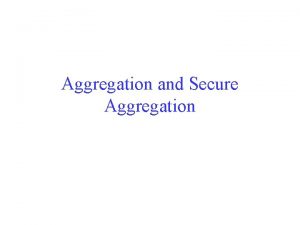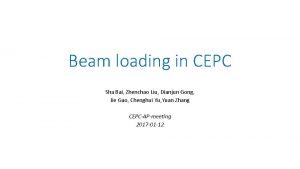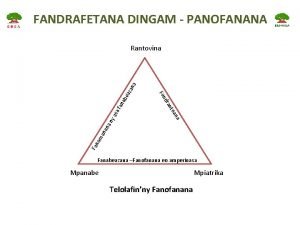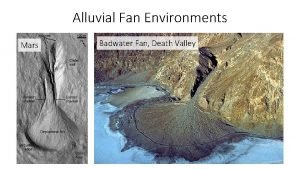Structurefree Data Aggregation Kaiwei Fan Sha Liu and






















- Slides: 22

Structure-free Data Aggregation Kaiwei Fan, Sha Liu, and Prasun Sinha (speaker) The Ohio State University Dept of Computer Science and Engineering

Outline n n n Introduction Structure-free Data Aggregation Simulation Results Experiments on a testbed Conclusion

Introduction n Data Aggregation q q n In-network processing Reduces communication cost Approaches q Static Structure n n q [LEACH, TWC ’ 02] [PEGASIS, TPDS ’ 02] Dynamic Structure n n [Directed Diffusion, Mobicom ‘ 00] [DCTC, Infocom ‘ 04]

Static Structure n Pros q q n Low maintenance cost Good for unchanging traffic pattern Cons q Unsuitable for event triggered network n n Long link-stretch Long delay sink

Static Structure n Pros q q n Low maintenance cost Good for unchanging traffic pattern Cons q Unsuitable for event triggered network n n Long link-stretch Long delay sink

Dynamic Structure n Pros q n Reduces communication cost Cons q High maintenance overhead sink

Structure-free Data Aggregation n Challenge q q n Approach q q n Routing: who is the next hop? Waiting: who should wait for whom? Spatial Convergence Temporal Convergence Routing? Waiting? Solution q q Data Aware Anycast Randomized Delay sink

Data Aware Anycast n n Improve Spatial Convergence Anycast q n One-to-Any forwarding scheme Anycast for Immediate Aggregation q q To neighbor nodes having packets for aggregation Keep Anycasting for Immediate Aggregation sink

Data Aware Anycast 50 nodes in 200 mx 200 m sink

Data Aware Anycast n Forward to Sink q q To neighbor nodes closer to the sink Using Anycast for possible Immediate Aggregation sink

Data Aware Anycast n Forwarding and CTS replying priority q q q Class A: Nodes for Immediate Aggregation Class B: Nodes closer to the sink Class C: Otherwise, do not reply mini-slot Sender Class A Nbr Class B Nbr Class C Nbr RTS CTS slot Class A Class B CTS Canceled CTS

Randomized Waiting n n Improve Temporal Convergence Naive Waiting Approach q q n Use delay based on proximity to sink (closer to sink => higher delay) Long delay for nodes close to the sink in case the event is near the sink Our Approach: Random Delay at Sources

Analysis n n Sink Y: Number of hops a packet is forwarded before being aggregated Assumptions: q q Each node has k choices for next hops closer to sink All n nodes have packets to send …… h=n/k n E[Y] = q x : random delay in [0, 1] picked up by a node q dh : random delay chosen by a node h hops away from sink n Total Number of Transmissions =

Analysis vs. Simulation n Results matches up to 40 hops Gap increases as network size increases Reason: transmission delay is ignored in analysis

Simulation Results n Evaluated Protocols q q q Opportunistic (OP) Optimum Aggregation Tree (AT) Data Aware Anycast (DAA) Randomized Waiting (RW) DAA+RW n Evaluated Metric q n Normalized Number of Transmissions Parameters Studied q q Maximum Delay Event Size Aggregation Function Network Size

Simulation Results – Maximum delay n Configuration q q q 33 x 33 grid network event moves at 10 m/s event radius: 200 m 140 nodes triggered by the event data rate: 0. 2 pkt/s data payload: 50 bytes n AT-2: Aggregation tree approach with varying delay n DAA+RW improve OP by 70%

Simulation Results – Maximum delay n n AT is sensitive to delay AT has best performance with highest delay

Simulation Results – Event Size n Configuration q q q n event radius: 50 m ~ 300 m 8 ~ 260 nodes triggered by the event radius: 200 m Key Observations q DAA+RW is much better than OP q DAA+RW is close to AT (optimal tree)

Simulation Results – Aggregation Ratio n Configuration q q q n Aggregation Ratio ρ: 0~1 Packet size: max(50, 50* (1 -ρ)* n) Max packet size: 400 bytes Key Observation q DAA+RW performs better than AT q Following the best tree is not optimum if the packet size is limited

Simulation Results – Network Size n event distance to the sink: 300 m ~ 700 m event radius: 200 m n Key Observation n q Improvement is higher for events farther from the sink

Experiment – Randomized Waiting n Linear network with 5 sources and 1 sink 0. 2 pkt/s data payload: 29 bytes n Key Observation n n q Delay as low as 0. 1 is sufficient for optimizing performance

Conclusion n Data Aware Anycast for Spatial Convergence Randomized Waiting for Temporal Convergence Efficient Aggregation without a Structure q q High Aggregation No maintenance overhead
 What is fanout in vlsi
What is fanout in vlsi Alex liu cecilia liu
Alex liu cecilia liu Líu líu lo lo ta ca hát say sưa
Líu líu lo lo ta ca hát say sưa Deu nexia fan sensornexia fan sensor
Deu nexia fan sensornexia fan sensor Kai-wei chang
Kai-wei chang Kaiwei chang
Kaiwei chang Kaiwei chang
Kaiwei chang Aggregator service in microservices
Aggregator service in microservices Ramackas
Ramackas What is logistics network configuration
What is logistics network configuration Data pre processing
Data pre processing Composition uml
Composition uml Difference between aggregation and composition
Difference between aggregation and composition Pods aggregation and silos in cloud computing
Pods aggregation and silos in cloud computing Aggregation in system analysis and design
Aggregation in system analysis and design Computing refers to
Computing refers to Cho sha cao
Cho sha cao Domain of tangent function
Domain of tangent function Staying healthy assessment
Staying healthy assessment Sha questionnaire
Sha questionnaire Sha 128
Sha 128 Master sha
Master sha Ntu
Ntu
